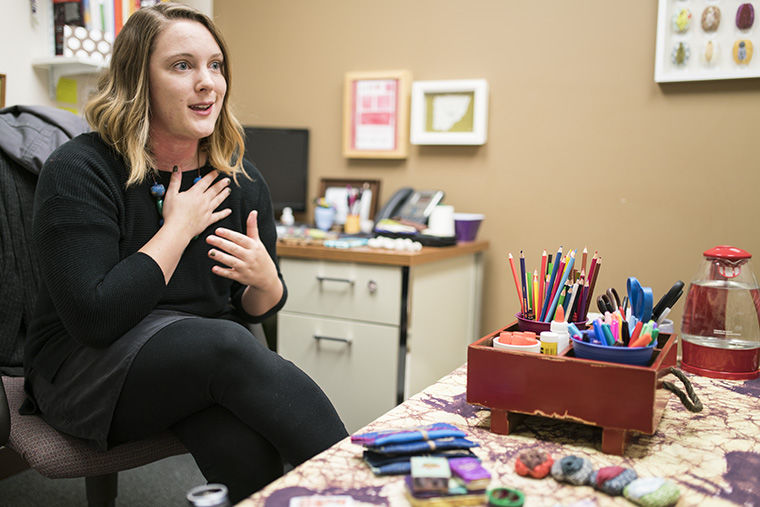Strong and sturdy—treating trauma survivors through art therapy
October 17, 2016
When Jordan Ferranto returns home from work as an art therapist, she changes out of work clothes and into her “home clothes.” This isn’t just a usual activity: It is a deliberate ritual that Ferranto said separates her from the trauma she witnesses every day.
“In the beginning, [the job] was really hard to handle,” Ferranto said. “I struggled a lot to the point where I was becoming affected by vicarious trauma and taking on the symptoms I saw in my clients.”
As an art therapist and general counselor at Rape Victim Advocates, 180 N. Michigan Ave., Ferranto, 24, said her clients are typically 18–60 years old. However, the organization accepts clients 12 years and older. She began working at RVA as a counseling intern before graduating from The School of the Art Institute of Chicago with a Master of Arts in art therapy in 2015.
Ferranto said she has been interested in art therapy since she was in eighth grade when her teacher introduced art therapy theories in class. The theories were simple and would now be considered outdated, but Ferranto was hooked by the healing powers of art.
“As an eighth grader, I thought, ‘This is so cool; you can tell so much from people’s drawings. I want to do that,’” Ferranto said, adding that art helped her work through her own struggles as a high school student.
With support from her mother, an artist herself, she pursued her career.
An art therapist at RVA provides a safe space for clients to work through their trauma in a positive environment. At times, survivors are met with an unforgiving society and family, according to Ferranto.
“The reason why counseling and therapy are so important is because survivors can come here and be met with [someone saying], ‘This is not your fault,’” Ferranto said.
Ferranto said making art herself helps the way she interacts with her clients. Being hands on with art can help art therapists gain more insight as they interact with trauma survivors.
According to Brittlyn Riley-Meade, an art therapist at Art Therapy Studio Chicago, creating art can help survivors work through trauma that may be difficult to express in words.
“[The way trauma] is stored in the brain is not in chronological order,” Riley-Meade said. “It is important for survivors to feel like they are in control of how they choose to talk or express [their experiences], especially in a situation where they may have been powerless.”
According to Cassandra Kaczor, a Chicago-based musician who primarily works with sexual trauma victims, a safe space is important for survivors to speak openly about their experiences.
“The moment [the people I work with] are able to take an experience or memory of something painful and materialize it into a piece of art, there is a weight lifted off of their backs,” Kaczor said, adding that everyone has a different relationship with the trauma they have experienced.
Ferranto’s love of art is evident in her office: A large glass frame of colorful knitted vulvas hangs on her wall, a project Ferranto began after she was inspired by hearing about the pain of her clients. They vulvas are coupled with words she would like to say to those clients—what she would like them to believe.
Ferranto hosted a knitting workshop to allow survivors to express their experiences. Along with her knitting workshop “Reclaiming Your Body,” she currently hosts a new open studio workshop entitled “Making Matters.” Both have empowering, positive affects on those who attend, Ferranto said.
“[The knitted vulvas] are a way to honor this body part that is stigmatized and shamed,” Ferranto said. “There is not a lot of spaces to talk about [trauma], let alone when horrible things happen to this part of [women’s] bodies.”
On the table in her office is a small bowl that can easily fit in the palm of a hand. The details are vibrant—purple and bedazzled. The story of the bowl comes from a young female client who had several experiences of sexual violence. Her self-esteem was considerably low, Ferranto said, and she believed the assaults were her fault.
During an appointment, Ferranto said the client finally revealed there was something inside her regarding her traumatic experience, but she did not know how to let it out.
“I said, ‘OK, something needs to come out. How would you envision it being held once it came out?’” Ferranto said.
The girl said, “a bowl.” So, they started making coiled bowls.
As they worked on their separate bowls, low self-esteem began to eat away at the girl, who crumpled up her bowl and threw it away multiple times. Finally, she made one, but she wanted to wait a while before continuing. Ferranto said she came back the next week, ready to make a new bowl but kept the old one. The new one was made in minutes: strong, sturdy and beautiful.
“[Survivors] are learning while they’re making—‘If I can make a bowl really strong, I can do the same thing for myself,’” Ferranto said.








